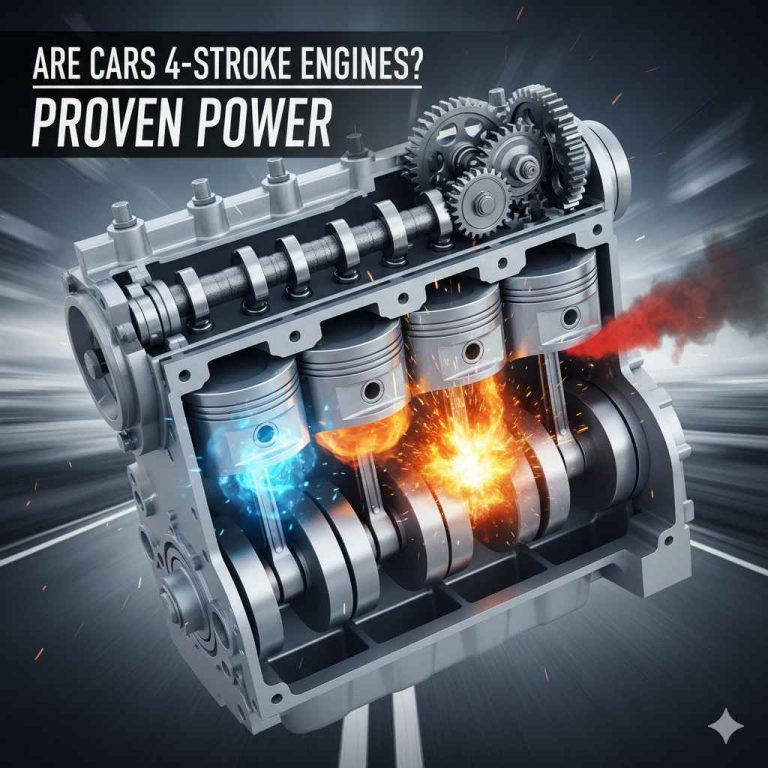How Do Gas Powered Cars Work? Unveiling the Mechanics
Gas powered cars work by sucking air and gasoline into a combustion chamber, compressing the air, and igniting the gasoline with a spark plug, which produces heat. This heat energy is then converted into mechanical energy, which powers the car’s engine and allows it to move forward.
Gasoline cars typically use spark-ignited internal combustion engines, where fuel is injected into the combustion chamber and combined with air before being ignited by a spark. Gas powered cars have become a staple in the modern world, providing convenient and reliable transportation for millions of people.
But have you ever wondered how these cars actually work? Understanding the inner workings of gas powered cars can help us appreciate the engineering marvel behind their functionality. We will delve into the mechanics of gas powered cars, exploring the process of combustion and how it powers the engine. So, let’s dive in and uncover the secrets of how gas powered cars work.
The Heart Of The Vehicle: Internal Combustion Engine
The basic mechanism behind gas-powered cars is the internal combustion engine. These engines come in different types, but they all work on the same principle. Fuel, usually gasoline, is injected into the combustion chamber and combined with air. The air/fuel mixture is then ignited by a spark from the spark plug, creating a controlled explosion. This explosion pushes the piston down, which in turn rotates the crankshaft and provides power to the wheels.
There are various types of internal combustion engines, including the spark-ignited system used in most gasoline cars. In this system, the fuel is injected into the combustion chamber and ignited by a spark. Another type is the compression-ignited system used in diesel vehicles, where the fuel ignites due to the high pressure and temperature in the combustion chamber.
Gasoline-powered vehicles primarily use the energy from the fuel for propulsion, but a significant amount is lost as heat, engine friction, and combustion inefficiency. However, gas-powered cars have advantages such as the availability of gas stations and faster refueling compared to electric vehicles.
Overall, understanding how gas-powered cars work can give you a better appreciation of the internal combustion engine and the technology behind it.
Fuel’s Journey: From Tank To Engine
Gasoline starts its journey in the tank, then the pump brings it into the fuel line. Before reaching the engine, it goes through a fuel filter to prevent clogging. Fuel injectors play a crucial role by combining air with fuel and delivering it into pistons. The air/fuel mixture is ignited by a spark from the spark plug, creating the energy needed to power the car.
Gasoline, one of the most energy-rich substances on Earth, undergoes a process in the car starting at the pump and ending with exhaust gases coming out of the muffler. This journey powers the vehicle and enables it to move efficiently from one place to another.
Ignition: Sparking The Power
Gas-powered cars work through a combustion process that involves ignition and the role of a spark plug. In a spark-ignited internal combustion engine, fuel is injected into the combustion chamber and combined with air. This air/fuel mixture is then ignited by a spark from the spark plug. The spark plug plays a crucial role in initiating the combustion process, creating a spark that ignites the mixture and produces power.
During combustion, the fuel undergoes a four-stroke process, including intake, compression, combustion, and exhaust. The intake stroke brings in the air/fuel mixture, which is compressed during the compression stroke. The combustion stroke is when the spark plug ignites the mixture, causing an explosion that generates power. Finally, the exhaust stroke expels the waste gases from the combustion process.
Gasoline is the fuel commonly used in gas-powered cars, and it is a highly energy-rich substance. Gasoline-powered cars have advantages such as a widespread availability of gas stations and faster refueling compared to electric vehicles. However, they also contribute to air pollution and are dependent on fossil fuels.
The Four-stroke Symphony
Gas powered cars work through a four-stroke process: intake, compression, power, and exhaust. During the intake stroke, the piston moves down, allowing the air-fuel mixture to enter the cylinder. The compression stroke follows, with the piston moving up to compress the mixture. The power stroke then occurs as the spark plug ignites the compressed mixture, causing an explosion that drives the piston down. Finally, the exhaust stroke expels the leftover gases from the combustion process. This continuous cycle of four strokes enables the engine to generate power and propel the vehicle forward.
Exhaust: From Energy To Emissions
Gas powered cars work by burning gasoline in an internal combustion engine. The combustion process produces energy that powers the car and also creates exhaust emissions. The exhaust system is responsible for guiding the emissions away from the engine and out of the vehicle. It consists of components such as the exhaust manifold, catalytic converter, muffler, and tailpipe. The catalytic converter plays a crucial role in emission control by converting harmful gases into less harmful ones before they are released into the environment. This process helps in reducing the impact of car emissions on the environment. Understanding the exhaust system and its role in emission control is essential for comprehending how gas powered cars work and their impact on the environment.
Cooling And Lubrication: Protecting The Engine
The cooling system of a gas-powered car is responsible for regulating the temperature of the engine. The engine produces a lot of heat while running, and if it gets too hot, it can cause damage to the internal components. The cooling system circulates coolant, which absorbs the heat and then releases it through the radiator. The coolant is also responsible for preventing the engine from freezing in cold weather.
Lubrication is also essential for the engine’s longevity. The engine has many moving parts that rub against each other, which can cause friction and wear. Lubricating oil is used to reduce this friction and keep the engine running smoothly. The oil is pumped throughout the engine by the oil pump and then filtered to remove any impurities.
Power Transmission: The Drive To The Wheels
In gas-powered cars, the engine ignites a mixture of air and fuel, generating power. This power is transmitted to the wheels through the transmission system, allowing the vehicle to move. The transmission system plays a crucial role in transferring the engine’s power to the wheels efficiently, enabling the car to operate smoothly.
| Gas powered cars use an internal combustion engine to produce power. This power is then transmitted to the wheels through the transmission system. The transmission system is responsible for converting the power produced by the engine into wheel movement. The process starts with the fuel being injected into the combustion chamber and combined with air, which is then ignited by a spark from the spark plug. This creates a controlled explosion that moves the pistons up and down. The movement of the pistons turns the crankshaft, which transfers power to the transmission system. The transmission system then uses gears to adjust the speed of the wheels based on the driver’s input. This allows the wheels to move at different speeds, such as when accelerating or decelerating. Ultimately, the transmission system plays a crucial role in the overall function of a gas powered car by ensuring that the power produced by the engine is effectively transmitted to the wheels. |
Fuel Efficiency And Economy
Gas powered cars work by burning gasoline in an internal combustion engine to power the vehicle. The fuel is injected into the combustion chamber and combined with air, then ignited by a spark from the spark plug. The resulting explosion pushes the pistons, turning the crankshaft and ultimately propelling the car forward. Fuel efficiency is affected by factors such as driving habits, vehicle maintenance, and road conditions. To optimize fuel usage, it’s important to drive at a steady speed, keep the car well-maintained, and avoid unnecessary idling. Additionally, using the correct grade of motor oil and keeping tires properly inflated can contribute to better fuel economy.
Advancements In Gas-powered Vehicles
Gas-powered vehicles have seen significant advancements in recent years, thanks to modern innovations in engine technology and fuel efficiency. The future of gasoline engines looks promising as researchers and engineers continue to explore ways to improve performance and reduce emissions.
Comparative Analysis: Gas Vs. Alternative Fuel Vehicles
Gas-powered cars have been the primary choice for transportation for many years. They offer several benefits that make them a popular option among consumers. Firstly, gas stations are more widely available compared to charging stations for alternative fuel vehicles, providing convenience and accessibility for drivers. Additionally, gas-powered cars have a quicker refueling time, allowing for reduced downtime and shorter trips on longer journeys.
However, gas-powered cars also face challenges and criticisms. One major concern is the environmental impact of burning gasoline, as it contributes to air pollution and greenhouse gas emissions. Moreover, gas-powered cars are dependent on fossil fuels, which are finite resources. The limited availability of these resources raises concerns about long-term sustainability and energy security.
As the demand for cleaner and more sustainable transportation options grows, alternative fuel vehicles are gaining popularity. These vehicles use alternative fuels such as electricity, natural gas, or hydrogen to power their engines. They offer the potential to reduce emissions and dependence on fossil fuels.
In conclusion, while gas-powered cars have their benefits, they also face challenges and criticisms related to environmental impact and resource dependence. Alternative fuel vehicles provide a promising solution for a more sustainable future of transportation.
Conclusion
Gas powered cars have been around for over a century and continue to be the primary mode of transportation for many people. Understanding how these vehicles work is essential for anyone who wants to maintain or repair them. From the fuel system to the engine, every component plays a vital role in the car’s functionality.
By learning how gas powered cars work, you can appreciate the complexity of these machines and make informed decisions about your vehicle. Whether you’re a car enthusiast or just curious about how things work, the inner workings of a gas powered car are truly fascinating.





